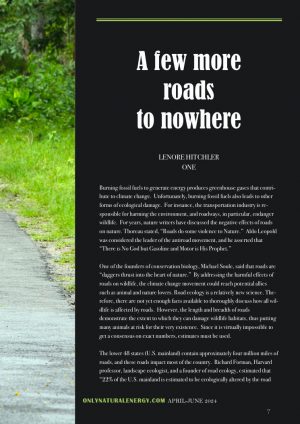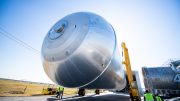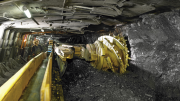 Burning fossil fuels to generate energy produces greenhouse gases that contribute to climate change. Unfortunately, burning fossil fuels also leads to other forms of ecological damage. For instance, the transportation industry is responsible for harming the environment, and roadways, in particular, endanger wildlife. For years, nature writers have discussed the negative effects of roads on nature. Thoreau stated, “Roads do some violence to Nature.” Aldo Leopold was considered the leader of the antiroad movement, and he asserted that “There is No God but Gasoline and Motor is His Prophet.” One of the founders of conservation biology, Michael Soule, said that roads are “daggers thrust into the heart of nature.” By addressing the harmful effects of roads on wildlife, the climate change movement could reach potential allies such as animal and nature lovers.
Burning fossil fuels to generate energy produces greenhouse gases that contribute to climate change. Unfortunately, burning fossil fuels also leads to other forms of ecological damage. For instance, the transportation industry is responsible for harming the environment, and roadways, in particular, endanger wildlife. For years, nature writers have discussed the negative effects of roads on nature. Thoreau stated, “Roads do some violence to Nature.” Aldo Leopold was considered the leader of the antiroad movement, and he asserted that “There is No God but Gasoline and Motor is His Prophet.” One of the founders of conservation biology, Michael Soule, said that roads are “daggers thrust into the heart of nature.” By addressing the harmful effects of roads on wildlife, the climate change movement could reach potential allies such as animal and nature lovers.
Road ecology is a relatively new science. Therefore, there are not yet enough facts available to thoroughly discuss how all wildlife is affected by roads. However, the length and breadth of roads demonstrate the extent to which they can damage wildlife habitats, thus putting many animals at risk for their very existence. Since it is virtually impossible to get a consensus on exact numbers, estimates must be used. The lower 48 states (U.S. mainland) contain approximately four million miles of roads, and these roads impact most of the country. Richard Forman, Harvard professor, landscape ecologist, and a founder of road ecology, estimated that “22% of the U.S. mainland is estimated to be ecologically altered by the road network.” An article in Frontiers in Ecology and the Environment added that 73% of the U.S. mainland is located within approximately 0.5 miles of a road of any type. Worldwide, there are vast networks of roads. For instance, both the Smithsonian and the BBC reported that worldwide there are a total of forty million miles of roads. Thus, the total land area that is impacted by roads is quite extensive.
Of course, to be fair and honest, roads benefit a small number of animal species. For example, an article in the Journal of Transport Geography reported that “Roads and road verges do provide habitat for some animals, particularly small mammals and insects and provide a source of food for carrion-feeders.”
However, for the most part, wildlife is imperiled by both roads themselves and the climate change that is produced by road transport. Road transport is estimated to cause 15% of global carbon dioxide (CO2) production and 10% of total greenhouse gas emissions. Unfortunately, wildlife, along with their food sources, have evolved to thrive in their native weather patterns, and are frequently not able to adapt to rapid climate change.
The most obvious effect of roads on wildlife is the vast number of animals killed on roads. One estimate is that in the United States, one million vertebrates are killed every day. According to the U.S. Federal Highway Administration, the total number of motor vehicle accidents with large wildlife is estimated to be between one to two million every year. These are gruesome statistics but the number of deaths of pets on roads is even more heartbreaking to their owners. Various sources estimate that 1.2 million dogs in the U.S. are killed yearly on roads. According to a news release from Indiana University, 5.4 million cats are hit by cars in the country every year.
Biologist Paul Donald, PhD. reported that in 1998, “Around 360 million birds, reptiles, amphibians and mammals die on the USA’s roads each year. A more recent study, published in 2014, suggested that the number of birds killed on the USA’s roads each year lies somewhere between 89 and 340 million. … Across Europe, perhaps 200 million birds and 30 million mammals are killed annually on reads.”
Besides vertebrates killed on roads, invertebrates such as insects also perish in large numbers. Donald provided various estimates on the death tolls of insects. For instance, researchers reported that in Illinois, 20 million butterflies are killed every week. Another U.S. study found that approximately 35 dragonflies are killed daily per 0.6 miles of road. A Netherlands study estimated that over a trillion insects might be killed by traffic each year in that country.
In addition to the large number of individual animals killed on roads, roads endanger the survival of many species. Roads lead to environmental fragmentation since many animals will not cross roads thus leading to smaller spatial environments. This has alarming consequences as many animal habitats are divided by roads. According to an article in the Annual Review of Ecology and Systematics, “All roads serve as barriers or filters to some animal movement. … The barrier effect tends to create metapopulations, e.g. where roads divide a continuous population into smaller, partially isolated local populations (subpopulations). Small populations fluctuate more widely over time and have a higher probability of extinction than do large populations.” Donald stated, “By one estimate, major roads alone have carved the planet’s land surface into more than 600,000 tarmac-edged traffic islands, most of them further subdivided by smaller roads.” It is especially egregious that the areas with the most biological diversity are often bisected by roads. For instance, in the U.S., national parks, forests, and wildlife refuges contain more than half a million miles of roads.
Road fragmentation of forests is quite extensive. Approximately 11% of all forest land in the U.S. mainland is located within 0.05 miles of a road according to an article in Frontiers in Ecology and the Environment. Global figures are similar. An article in Science reported that 70% of the world’s forests now occur within approximately 0.6 miles of a forest edge.”
Besides the harm caused by road-induced fragmentation of forests, wetlands are also endangered by roads. Wetlands are extremely important to the environment as they remove pollutants and are major sites of biological diversity. Unfortunately, the construction of roads leads to the loss of wetlands. According to the U.S. Bureau of Transportation Statistics, between 310,000 and 570,000 acres of wetland were lost due to the construction of roads by the Federal Aid Highway Program between 1955 and 1980. The book Road Ecology reported that “Although wetlands constitute only 5% of the total land surface area in the USA, over a third of all rare and endangered animal species reside there. … the species richness of birds, amphibians/reptiles, and plants was found to be negatively correlated to the density of paved roads around a wetland.” Also, pollutants from roadways eventually wind up in wetlands endangering wildlife health.
Road pollution endangers the health of many animals, starting with the roads themselves. Road surfaces erode which therefore releases pollutants into the environment. Motor vehicles also produce pollutants. Road-based pollutants contribute to air pollution which then ends up on the ground leading to soil pollution. These pollutants frequently circulate into waterways and eventually into the ocean. Thus, terrestrial and aquatic animals are endangered by breathing air pollutants, consuming polluted water, and eating plants that are contaminated by polluted soils. Carnivores consume even more toxins the further up they are on the food chain.
Motor vehicle tires also release pollutants into the environment. Donald reported on the heavy toxic toll that tires place on the environment. One and a half trillion ultrafine particulates are produced approximately every 0.6 miles due to tire wear. Both particles from tire wear itself and road wear from tire friction are toxic pollutants and are possibly carcinogenic. Worldwide, approximately six million tonnes of microplastics from tire wear on roads are produced every year. Estimates vary from 10% to 60% of all microplastics in the oceans come from tires. These toxins frequently end up within the bodies of wildlife thus imperiling their health.
Besides writing about tires, Donald also reported about pollution from road salt. In the U.S., approximately twenty million tons of salt are spread on roads yearly. Worldwide, around sixty million tons are used every winter.
If animals consume too much salt, their health is endangered. For example, Donald reported that “Frogs living near salted roads suffer from oedma, a bloating of the body caused by fluid retention, which restricts their mobility and reduces their lifespans. … Salt also impacts frogs’ ability to survive the winter by reducing their natural anti-freeze, it makes them more vulnerable to diseases, it affects their immune systems, and in larval stages, it interferes with the functioning of the gills and leads to a higher rate of physical defects during development.” According to science writer Ben Goldfarb, “road salt (principally chloride) slows trout growth, makes frogs more susceptible to viruses, and ferments dead zones. Of course, other wildlife is also endangered by road salt.
In addition to toxic air, soil, and water pollution caused by motor vehicles, traffic is a major source of noise pollution. Noise pollution increases environmental fragmentation and habitat loss. According to an article in the Annual Review of Ecology and Systematics, “Many possible reasons exist for the effects of traffic noise. Likely hypotheses include hearing loss, increase in stress hormones, altered behaviors, interference with communication during breeding activities, differential sensitivity to different frequencies, and deleterious effects on food supply or other habitat attributes.” An article in PHYS ORG added that “Persistent loud noise stresses wildlife. It can alter animal behavior, including communication, community structure, distribution, fitness, foraging mating, movement and reproduction. Noise can make some species more vulnerable to predators and cause wildlife to avoid certain areas.” Goldfarb added that “A mere three-decibel increase in background noise halves the ‘listening area,’ the space in which an animal can pick up a signal. By disturbing animals, noise also disrupts the ecological processes they catalyze, among them seed dispersal, pollination, and pest control.”
Birds are particularly vulnerable to noise pollution. According to an article in Nature Ecology & Evolution, “Studies of birds showed that noise levels from 23 to 93 dB [decibels] led to changes in abundance, species richness, community composition, physiology, reproduction, mating behaviours, vocalization characteristics, vigilance and foraging behaviours.”
Noise pollution contributes to the stress that birds face. Donald reported that “One of the first studies to show that traffic noise can elevate stress levels in birds was undertaken in Gunnison National Forest, Colorado, where white-crowned sparrows nesting near a road were found to have higher concentrations of the stress hormone corticosterone in their blood than those nesting further away. … The road in question was an unpaved track carrying only a few slow-moving vehicles each day. … Another American study, this time of breeding tree swallows, found that exposing breeding birds to just six hours of artificial traffic noise every second day caused their chicks to grow more slowly and to be in worse health than those left in peace and quiet. This appears to be a common pattern; the stress caused to birds by even low levels of traffic noise results in a drop in the number of eggs laid and the health of the chicks that hatch. A study using data on over 100 bird species from across the USA has found that as traffic noise increases, so nesting success fails.” Of course, birds are only one of many types of animals that are imperiled by noise pollution.
Along with noise pollution, light pollution also endangers wildlife. An article in Trends in Ecology and Evolution reported that “Most organisms, including humans, have evolved molecular circadian clocks controlled by natural day-night cycles. These clocks play key roles in metabolism, growth and behavior. A substantial proportion of global biodiversity is nocturnal (30% of all vertebrates and 60% of all invertebrates.) … Light pollution threatens biodiversity through changed night habits (such as reproduction and migration) of insects, amphibians, fish, birds, bats and other animals and it can disrupt plants by distorting their natural day-night cycle. Many insects actively congregate around light sources until they die of exhaustion. … Migratory fish and birds can become confused by artificial lighting.” Donald also stated that the global collapse of insect populations may be partly caused by light pollution that disrupts natural processes.
Light pollution is also life-threatening to even more animal species. An article in the European Heart Journal reported that “In an animal study, constant illumination accelerated the onset of metabolic syndrome and spontaneous and chemically induced tumorigenesis, and shortened the life span in both male and female rats.”
Thus, roads endanger the health and the very existence of wildlife. The climate change movement can gain new adherents if they discuss these dangers with the special interest groups that already care about wildlife and those who generally care about nature. Vegans and vegetarians, animal rights groups, birders, and pet lovers might be moved to action. Hikers, cross-country skiers, campers, hunters, those who fish, and all other nature lovers are also potential allies.
Roads are not permanent because they deteriorate and then need to be resurfaced and restored. The climate change movement could use the need for repetitive expensive repairs as an opportunity to advocate for replacing roads with more ecological and sustainable alternatives. Passenger and freight trains and public transportation could be re-established and expanded. Less reliance on motor vehicles means less greenhouse gases and climate change. As an added benefit of switching to alternatives to roads, flora and fauna might even go from facing extinction to being more likely to continue their life on Earth.
Lenore Hitchler





